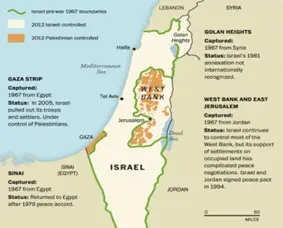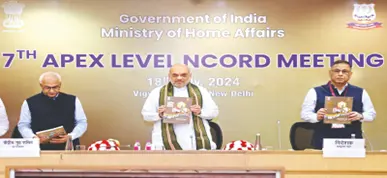Thursday, 25th July 2024
Neighbourhood First in MEA’s Aid Allocation
Why in the news?
- In the recently announced Union Budget 2024-25, the Ministry of External Affairs (MEA) has outlined its development assistance plans, focusing on strategic partners and neighbouring countries.
- This initiative is geared towards promoting regional connectivity, cooperation, and stability in line with India’s Neighbourhood First Policy.
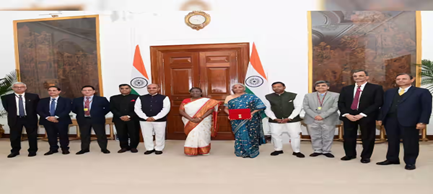
How is the Development Aid Distributed Among Countries?
- A major chunk of the Ministry of External Affairs’ outlay, Rs 4,883 crore, has been earmarked for “aid to countries.” The allocation is distributed as follows:
- Bhutan:
- Received the highest aid at Rs 2,068.56 crore, though slightly less than last year’s Rs 2,400 crore.
- Nepal:
- Allocated Rs 700 crore, up from Rs 550 crore last year.
- Maldives:
- Maintained a consistent allocation of Rs 400 crore, despite a higher revised amount of Rs 770.90 crore for the previous year.
- Sri Lanka:
- Received Rs 245 crore, an increase from Rs 150 crore last year.
- Afghanistan:
- Receives Rs 200 crore, illustrating India's role in aiding the country's stability and development amidst ongoing challenges.
- Iran:
- Chabahar Port Project continues to receive Rs 100 crore, unchanged for the past three years.
- Africa:
- African countries collectively received Rs 200 crore, showcasing India's expanding influence and engagement with the continent.
- Seychelles:
- Receives Rs 40 crore, up from Rs 10 crore.
- Bhutan:
What are the Benefits of Development Aid Granted to Neighbouring Countries?
- Strengthening Diplomatic Relations:
- Enhances diplomatic ties, fostering stronger political and economic relationships.
- Promoting Regional Stability:
- Financial support helps stabilise neighbouring countries, which can lead to a more secure and stable region, benefiting India's strategic interests.
- Supporting Economic Development:
- Contributes to infrastructure projects, development programs, and other initiatives that can boost economic growth in recipient countries, creating a more prosperous region.
- Example: Chabahar port in Iran.
- Encouraging Trade and Investment:
- Improved infrastructure and economic conditions in neighbouring countries can lead to increased trade and investment opportunities for India.
- Example: Agartala-Akhaura railway project between India and Bangladesh.
- Enhancing Strategic Influence:
- Providing aid allows India to exert influence and build alliances, ensuring that neighbouring countries have positive engagements with India and align more closely with its interests.
- Example: Bhutan’s favour to India on the Doklam issue.
- Addressing Humanitarian Needs:
- Aid often addresses urgent humanitarian needs, such as health care, education, and disaster relief, improving the quality of life in recipient countries.
- Example: India launched "Operation Karuna" to provide humanitarian assistance to Myanmar during Cyclone Mocha.
- Strengthening Soft Power:
- By investing in neighbouring countries' development, India bolsters its soft power and reputation as a responsible regional leader.
- Helps alleviate the Big Brother syndrome among India's smaller neighbours
What is the Importance of the Neighbourhood First Policy for India?
- Terrorism and Illegal Migration:
- Threats: India faces terrorism and illegal migration threats, including the smuggling of weapons and drugs, from its immediate neighbours.
- Improvement: Better relations can improve border security infrastructure and monitor demographic changes due to illegal migration.
- Relations with China and Pakistan:
- Strained Relations: Relations with China and Pakistan are strained, particularly due to terrorism linked to Pakistan.
- Engagement: Engaging in regional and multilateral organisations can highlight Pakistan’s role in terrorism and create a common platform for counter-terrorism under the Neighbourhood First Policy.
- Investment in Border Infrastructure:
- Deficiency: There is a deficiency in border infrastructure and the need to stabilise and develop border regions.
- Connectivity: Improved connectivity infrastructure like cross-border roads, railways, and ports, and exploring a regional development fund for such infrastructure.
- Monitoring Line of Credit (LOC) Projects:
- Increase: India’s LOC to neighbours has increased significantly, with 50% of global soft lending going to them.
- Influence: It enhances India’s influence in the region, expands Indian firms' presence, and builds economic linkages with recipient countries.
- Defence and Maritime Security:
- Cooperation: Defence cooperation is crucial, with joint military exercises conducted with various neighbours.
- Maritime Awareness: It helps in enhancing maritime domain awareness in the extended neighbourhood.
- Development in the North-Eastern Region:
- Crucial: The North-Eastern region’s development is crucial for the Neighbourhood First and Act East Policies.
- Connectivity: Countries like Myanmar and Thailand can help improve connectivity, economic development, and security in the North-Eastern Region (e.g., the India-Myanmar-Thailand Trilateral Highway).
- Tourism Promotion:
- Tourism: India is a major source of tourists for Maldives and Bangladesh and a destination for Nepali religious tourism.
- Cultural Exchange: Tourism fosters cultural exchange, leading to increased interest in Indian culture and businesses, potentially boosting exports of Indian cultural products and services.
- Multilateral Organisations:
- Engagement: India’s engagement with neighbours is driven by regional mechanisms like SAARC and BIMSTEC.
- Leadership: Both help India assert its leadership role in South Asia and counterbalance the influence of other major powers in the region.
What are the Challenges in India's Relationship with its Neighbouring Countries?
- Border Disputes:
- Disagreements: Disagreements over borders, especially with China and Pakistan, lead to tensions and conflicts.
- China’s Influence: China’s growing influence in the South Asian region and its close ties with Pakistan pose strategic challenges.
- Terrorism:
- Support from Pakistan: Pakistan has continuously provided support, safe havens, and funding to various militant groups, such as Lashkar-e-Taiba (LeT) and Jaish-e-Mohammed (JeM), which have carried out attacks in India.
- Illegal Migration:
- Concerns: The influx of illegal migrants from Bangladesh into India causes demographic and security concerns.
- Trade Imbalances:
- Economic Issues: Economic issues and trade barriers with neighbours like Pakistan, Bangladesh, and Nepal affect relations.
- Trade Restrictions: Issues related to trade restrictions and tariffs have often exacerbated diplomatic tensions.
- Water Disputes:
- Conflicts: Conflicts over sharing river waters, such as the Indus and Teesta rivers, strain ties with Pakistan and Bangladesh respectively.
- Internal Conflicts:
- Instability: Political instability or disputes in neighbouring countries, like Nepal and Bangladesh, impact bilateral relations.
- Diplomatic Relations:
- Minorities and Governance: Issues such as the treatment of minorities in Sri Lanka and India's stance on Myanmar’s government create friction (e.g., Free Movement Regime (FMR) issue with Myanmar).
- Environmental Issues:
- Natural Disasters: Natural disasters and environmental problems, like flooding in Bangladesh, require joint efforts and can affect relations.
- Ecology Concerns: Bhutan’s concerns over the environmental impact of BBIN and tourism on its fragile ecology.
- Regional Cooperation:
- Disagreements: Disagreements within regional organisations like SAARC and BIMSTEC can hinder effective cooperation.
Way Forward for India's Neighbourhood First Policy:
- Strengthening Diplomatic Engagement:
- Regular Dialogues: Establish and maintain regular diplomatic dialogues and high-level meetings to address and resolve issues.
- Dispute Resolution Mechanisms: Develop and institutionalise mechanisms for resolving disputes, such as joint committees and arbitration panels.
- Enhancing Economic Cooperation:
- Trade Agreements: Negotiate and implement fair trade agreements that address imbalances and promote mutual benefits.
- Infrastructure Collaboration: Collaborate on roads, railways, and energy corridors to improve connectivity and economic integration.
- Promoting Security and Stability:
- Regional Security Initiatives: Coordinate on regional security initiatives to address common threats like terrorism and illegal migration.
- Joint Task Forces: Establish joint task forces and intelligence-sharing mechanisms.
- Fostering People-to-People Connections:
- Educational and Tourism Initiatives: Increase educational and tourism initiatives to build mutual understanding and goodwill among populations.
- Addressing Environmental and Humanitarian Issues:
- Joint Environmental Efforts: Synergize on natural disasters and environmental problems using joint efforts and regional plans.
- Humanitarian Assistance: Provide humanitarian assistance and support in times of crisis, fostering goodwill and cooperation.
- Strengthening Regional Organisations:
- Active Participation: Actively participate in regional organisations like SAARC and BIMSTEC to address regional issues and improve their mechanisms for decision-making and implementation.
- Addressing Internal and External Factors:
- Domestic Policy Alignment: Ensure that domestic policies do not adversely impact relations with neighbouring countries.
- Balanced Policies: Strive for balanced policies that consider both domestic and international implications aligning with the principles of the Gujral Doctrine.
|
UPSC Civil Services Examination, Previous Year Question (PYQ) Mains Q:1 Critically examine the compulsions which prompted India to play a decisive role in the emergence of Bangladesh. (2013) Q:2 Project ‘Mausam’ is considered a unique foreign policy initiative of the Indian government to improve relationships with its neighbours. Does the project have a strategic dimension? Discuss. (2015) Q:3 What is meant by Gujral doctrine? Does it have any relevance today? Discuss. (2013) Q:4 “The diverse nature of India as a multi-religious and multi-ethnic society is not immune to the impact of radicalism which is seen in her neighbourhood.” Discuss along with strategies to be adopted to counter this environment. (2014) |
Source: IE
UNAIDS Global AIDS Assessment
Why in the news?
- Recently, the 2024 UNAIDS Global AIDS Update, titled "The Urgency of Now: AIDS at a Crossroads," provided a crucial overview of the current state of the HIV/AIDS epidemic and the global response to it.
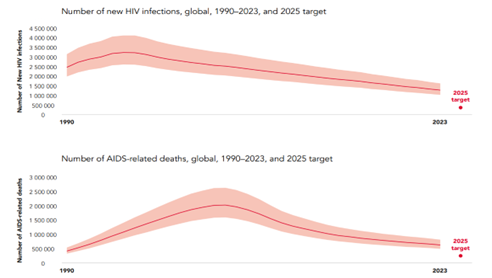
What are the Key Highlights of the Reports?
- About:
- The report highlights the potential to end AIDS as a public health threat by 2030. It emphasises the need to tackle inequalities, enhance access to prevention and treatment, and ensure sustainable resources.
- Progress and Challenges:
- Reduction in New HIV Infections and AIDS-Related Deaths:
- Since 2010, there has been a 39% reduction in new HIV infections worldwide, with sub-Saharan Africa experiencing the most significant decline at 56%.
- In 2023, the number of new HIV cases was lower than at any time since the late 1980s, and nearly 31 million people were receiving antiretroviral therapy (ART).
- AIDS-related deaths have dropped to their lowest level since the peak in 2004, primarily due to improved access to ART.
- Regional Disparities:
- While sub-Saharan Africa has made considerable progress, regions such as Eastern Europe, Central Asia, Latin America, and the Middle East and North Africa have seen increases in new HIV infections.
- For the first time, more new HIV infections occurred outside of sub-Saharan Africa than within it.
- Key Affected Groups:
- Key populations, including sex workers, men who have sex with men, people who inject drugs, transgender individuals, and those in prisons, remain at high risk of HIV infection due to insufficient prevention programs and ongoing stigma and discrimination.
- Community-led interventions are vital but often suffer from inadequate funding and recognition.
- Prevention and Treatment Gaps:
- HIV prevention efforts are lacking, particularly in areas like pre-exposure prophylaxis (PrEP) and harm reduction for people who inject drugs.
- Approximately 9.3 million people living with HIV are not receiving ART, with children and adolescents being disproportionately affected.
- Reduction in New HIV Infections and AIDS-Related Deaths:
UNAIDS:
- UNAIDS serves as a model for United Nations reform and is unique as the only cosponsored Joint Programme within the UN system.
- It leverages the experience and expertise of 11 UN system Cosponsors and is distinguished as the sole UN entity with civil society representation on its governing body.
- UNAIDS spearheads the global initiative to end AIDS as a public health threat by 2030, aligning with the Sustainable Development Goals.
What is HIV/AIDS?
About:
- HIV/AIDS is a viral infection that targets and destroys CD4 cells (T cells), impairing the immune system.
- Untreated HIV leads to a drastic decrease in these cells, making the body vulnerable to infections and cancers.
- AIDS is the advanced stage where the immune system is severely compromised.
Causes:
- HIV is spread through contact with infected bodily fluids such as blood, semen, vaginal fluids, and breast milk.
- Transmission occurs via sexual contact, needle sharing, from mother to child during birth or breastfeeding, and rarely through blood transfusions or organ transplants.
Symptoms:
- Clinical Latent Infection: HIV is active but reproduces minimally, often with no symptoms or mild ones.
- Acute HIV Infection: Symptoms resemble the flu, including fever, swollen lymph nodes, sore throat, rash, muscle and joint aches, and headaches.
- AIDS: Symptoms are severe, such as rapid weight loss, recurring fever, night sweats, and extreme fatigue.
Diagnosis:
- HIV Antibody/Antigen Tests: Detect antibodies or antigens in blood or oral fluid.
- Nucleic Acid Tests (NATs): Identify the virus itself and can detect HIV earlier than antibody tests.
Treatment and Management:
- Antiretroviral Therapy (ART): A daily regimen of HIV medicines that controls the virus, extending life expectancy and reducing transmission risk.
- Pre-exposure Prophylaxis (PrEP): A daily pill for those at high risk of HIV, reducing infection risk when taken consistently.
- New Drug Approval: A UK-approved HIV drug reduces the daily pill regimen to six injections per year.
What are the Key Suggestions from the Report?
- Accelerating HIV Prevention:
- Expand access to prevention services for key populations such as sex workers, men who have sex with men, people who inject drugs, transgender individuals, and those in prisons.
- Reinstate and fund condom programs to promote safe sex, particularly in regions with declining condom use.
- Increase the availability and use of PrEP to achieve the global target of 21.2 million users by 2025.
- Enhancing Treatment and Care:
- Ensure that 95% of people living with HIV are on ART by 2025, up from the current 77%.
- Improve diagnosis and treatment for children with HIV, as only 48% are currently on ART compared to 78% of adults.
- Integrate HIV services with broader health services to address comorbidities like tuberculosis, hepatitis, and non-communicable diseases.
- Addressing Inequalities and Stigma:
- Remove laws that criminalise HIV transmission, exposure, and non-disclosure, as well as those targeting key populations.
- Implement programs to reduce stigma and discrimination in healthcare and community settings and ensure legal protections for people living with HIV and key populations.

- Community-Led Responses:
- Strengthen community-led organisations to deliver HIV services, aiming for these organisations to provide 30% of testing and treatment services and 80% of prevention services for high-risk populations.
- Sustainable Financing:
- Address the funding shortfall for HIV programs, requiring an additional USD 9.5 billion by 2025 to meet targets.
- Explore new funding sources and mechanisms to sustain the HIV response, particularly in low- and middle-income countries.
|
UPSC Civil Services Examination, Previous Year Question (PYQ) Prelims: Q;1 Consider the following statements: (2021)
Which of the statements given above is/are correct?
Ans: (b)
Q:2 Which of the following diseases can be transmitted from one person to another through tattooing? (2013)
Select the correct answer using the codes given below:
Ans: (b)
Q:3 With regard to the transmission of the Human Immunodeficiency Virus, which one of the following statements is not correct? (2010)
Ans: (a)
Q:4 Consider the following statements: (2010)
Which of the statements given above is/are correct?
Ans: (c) Mains: Q:1 In order to enhance the prospects of social development, sound and adequate health care policies are needed particularly in the fields of geriatric and maternal health care. Discuss. (2020) |
For the social sector, it is old wine in an old bottle
Why in the news?
- Recently, released budget 2024 maintains the same approach as previous years regarding social sector allocations.
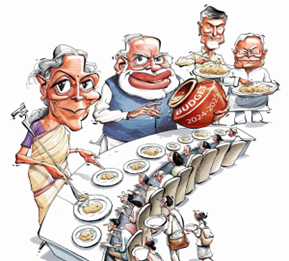
Decreasing Allocations in the Budget for Social Sector Schemes:
- Education Sector: Allocations for school education increased by ₹5,000 crore and for higher education by ₹3,000 crore. Increased recoveries from fees and self-financing schemes suggest a shift towards cost recovery in educational institutions.
- Health Sector: Allocation for the Department of Health and Family Welfare rose by only ₹1,500 crore.
- Food Subsidy: Limited increase in food subsidies despite rising economic costs and the need to update coverage based on the latest population figures.
- Shift in Approach: Greater emphasis on cost-effectiveness and privatisation in education and health, shifting focus towards contributory schemes like the Atal Pension Yojana.
Social Sector Schemes in Budget 2024-25:
- Social Protection Schemes:
- POSHAN Scheme: Slight increase from ₹11,600 crore to ₹12,467 crore, still less than the actual expenditure in 2022-23.
- Saksham Anganwadi Scheme: Allocation increased to ₹21,200 crore from ₹20,554 crore, but no increase in salaries for Anganwadi workers or honorarium for mid-day meal cooks.
- Maternity and Social Assistance:
- Samarthya Scheme: Budget reduced to ₹2,517 crore from ₹2,582 crore. The PMMVY scheme’s maternity benefits have remained unchanged since 2017.
- NSAP: Allocation for social security pensions remains unchanged at ₹9,652 crore, reducing real coverage and value.
- Schemes for the Unemployed:
- Prime Minister’s Package for Employment and Skilling: Includes government-sponsored internships, formalisation of jobs through incentives for EPFO enrollments, and skill-development programs.
- Allocation of ₹2 lakh crore over five years for the employment package, linked to industry response.
- Schemes for Street Vendors:
- PM SVANidhi Scheme (PM Street Vendor’s AtmaNirbhar Nidhi):
- Aims to benefit over 50 lakh street vendors across India. All lending institutions, including NBFCs, are participating in the scheme to provide affordable loans to street vendors.
- PM SVANidhi Scheme (PM Street Vendor’s AtmaNirbhar Nidhi):
Employment Challenges:
- Stagnant Wages and Dampened Demand: The Indian economy faces significant challenges with stagnant wages, affecting consumer demand and hindering overall economic growth and employment generation.
- Reliance on the Private Sector for Job Creation:
- The government increasingly looks to the private sector to address employment challenges.
- Initiatives like the ‘Prime Minister’s Package for Employment and Skilling’ aim to incentivize private sector job creation through government-sponsored internships and skill development programs.
- Limited Budgetary Allocations: The budgetary allocations for employment-related schemes are limited, with the entire employment package amounting to ₹2 lakh crore over five years.
- Focus on Supply-Side Solutions: The current approach emphasises supply-side measures to incentivize the private sector rather than addressing underlying demand-side issues, such as low consumer spending and economic uncertainty.
Way Forward:
- Enhance Social Sector Investments: Significantly increase budget allocations for critical social sector schemes, particularly in education, health, and social protection.
- Comprehensive Employment Strategy: Develop a holistic approach to employment that addresses both supply and demand-side issues.
Source: TH
Skill Loan Scheme
Why in the news?
- The Union Finance Minister recently announced a revision to the model skill loan scheme, now facilitating loans up to Rs 7.5 lakh backed by a government-promoted fund guarantee.

About Skill Loan Scheme:
- Introduction:
- Launched in July 2015, the scheme offers institutional credit to individuals pursuing skill development courses aligned with National Occupations Standards and Qualification Packs.
- These courses, conducted by training institutes adhering to the National Skill Qualification Framework (NSQF), lead to certifications, diplomas, or degrees.
- Applicability:
- The scheme applies to all member banks of the Indian Banks’ Association (IBA) and other banks and financial institutions as advised by the Reserve Bank of India (RBI).
Features:
- Eligibility:
- Any Indian national admitted to a course run by Industrial Training Institutes (ITIs), Polytechnics, schools recognized by Central or State Education Boards, colleges affiliated with a recognized university, or training partners affiliated to National Skill Development Corporation (NSDC) Sector Skill Councils, State Skill Mission, or State Skill Corporation.
- Age Restriction: No specific age restriction.
- Courses: Aligned with NSQF.
- Duration of Course: No minimum duration.
- Quantum of Finance: Initially Rs 5,000 to Rs 1,50,000, now increased to Rs 7.5 lakh.
- Moratorium: Duration of the course.
- Repayment Period:
- Loans up to Rs. 50,000: Up to 3 years.
- Loans between Rs. 50,000 to Rs. 1 lakh: Up to 5 years.
- Loans above Rs. 1 lakh: Up to 7 years.
- Coverage: Course fees and expenses for assessment, examination, study material, etc.
- Interest Rate: Interest rate charged by the bank should not exceed 1.5% p.a. over the repo-linked lending rate (RLLR) or any other external benchmark interest rate conforming to RBI guidelines.
- Collateral: No collateral required.
Scheme Process:
- Scheme A: One Month's Wage for Freshers
- This initiative provides a one-month wage for new entrants into the formal workforce. Supported by a Direct Benefit Transfer (DBT) of up to ₹15,000, the amount is disbursed in three instalments.
- With a salary cap of ₹1 lakh per month, the scheme aims to support 210 lakh youth entering the workforce for the first time.
- Scheme B: Job Creation in Manufacturing
- Targeting first-time employees, this scheme incentivizes job creation in the manufacturing sector.
- It offers incentives related to Employees' PF Organization (EPFO) contributions for both employees and employers during the first four years of employment, promoting substantial job growth in this vital sector.
- Scheme C: Support to Employers
- This scheme is designed to benefit 30 lakh youth and additional employment across all sectors.
- It reimburses employers up to ₹3,000 per month for two years for each additional employee's EPFO contribution.
- The initiative aims to incentivize the employment of 50 lakh people, boosting overall employment rates
Credit Guarantee Fund for Skill Development (CGFSSD):
- Notification: Brought into force by the Ministry of Skill Development and Entrepreneurship (MSDE) in November 2015.
- Administration: Administered by the National Credit Guarantee Trust Company (NCGTC).
- Credit Guarantee: Banks can apply to NCGTC for a credit guarantee against defaults. NCGTC provides this guarantee at a nominal fee, not exceeding 0.5% of the outstanding amount.
- Guarantee Cover: Maximum of 75% of the outstanding loan amount (including interest, if any).
Conclusion
For the first time ever, the Union Budget 2024 places a significant focus on employment-linked schemes, setting a new precedent for prioritising job creation and skilling in our nation.This landmark budget introduces innovative approaches to directly link incentives with employment generation, ensuring that economic growth translates into real, tangible opportunities for our youth.
Source: BS
Defence funds decline, BRO gets backing
Why in the news?
- Union Finance Minister Nirmala Sitharaman has allocated ₹6.22 lakh crore for the Defence Ministry for 2024-25, matching the amount presented in the interim Budget in February.
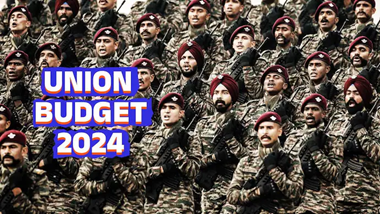
Budgetary Allocation for Different Sectors:
- Border Roads Organisation (BRO)
- Funding Increase: The BRO received a significant increase in funding, with an allocation of ₹6,500 crore.
- Objective: This funding aims to improve border infrastructure and promote socio-economic development in border areas.
- Indian Coast Guard
- Allocation: ₹7,651.8 crore, which is 6% lower than the revised estimates for FY24.
- Capital Expenditure: Of the total allocation, ₹3,500 crore is designated for capital expenditure to enhance maritime capabilities.
- Innovation in Defence
- Additional Allocation: ₹400 crore has been allocated for innovation through the Acing Development of Innovative Technologies with iDEX (ADITI) scheme.
- Goal: Engage startups and MSMEs in developing indigenous defence technologies.
- Overall Allocation Breakdown
- Capital Expenditure: 27.66%
- Revenue Expenditure: 14.82%
- Pay and Allowances: 30.66%
- Defence Pensions: 22.7%
- Civil Organizations under Defence Ministry: 4.17%
Marginal Capex Push:
- Slight Increase in Capital Expenditure
- Focus: Strengthening the capabilities of the armed forces and enhancing domestic procurement.
- Strategic Infrastructure Development
- Emphasis: Increased allocation to the BRO and Coast Guard indicates a push towards improving infrastructure in border areas and maritime security.
- Focus on Indigenous Solutions
- Domestic Procurement: Emphasis on domestic capital procurement and innovation through the iDEX scheme aims to bolster self-reliance in defence technology.
- Long-term Strategic Goals
- Operational Preparedness: Allocations are aligned with enhancing operational preparedness and infrastructure development in sensitive regions.
- Conservative Growth: Overall growth in capital expenditure is viewed as conservative.
- Balancing Defence Needs with Budget Constraints
- Critical Needs: The budget seeks to address critical defence needs.
- Budget Constraints: Slight reduction in the overall percentage of the budget allocated to defence suggests balancing between defence priorities and other pressing social and economic needs.
Way Forward:
- Enhance Focus on Indigenous Production
- Promote Indigenous Capabilities: Increase investments in research and development.
- Incentives: Provide incentives for domestic manufacturers to produce advanced defence technologies.
- Strengthen Infrastructure Development
- Continued Emphasis: Prioritise infrastructure projects, particularly in border areas, to enhance national security and socio-economic development.
- Effective Utilisation: Ensure allocations are effectively utilised for maximum impact.
Source: TH
Angel Tax
Why in the news?
- Recently, the Union Minister for Finance proposed to abolish ‘angel tax’ for all classes of investors, while presenting the Union Budget 2024-25 in Parliament.

About Angel Tax:
- Definition:
- It was levied on the capital raised via the issue of shares by unlisted companies from an Indian investor if the share price of issued shares is seen in excess of the fair market value of the company.
- The excess funds raised at prices above fair value are treated as income, on which tax is levied.
- Genesis:
- It derives its genesis from section 56(2) (viib) of the Income Tax Act, 1961.
- It was first introduced in 2012 to prevent black money laundering through share sales.
- Tax Rate:
- It was levied at a rate of 30.9% on net investments in excess of the fair market value.
- Exemptions Announced in 2019:
- The Government announced an exemption from the Angel Tax for startups on the fulfilment of certain conditions:
- The startup should be recognized by the Department for Promotion of Industry and Internal Trade (DPIIT) as an eligible startup.
- The aggregate amount of paid-up share capital and share premium of the Startup cannot be more than ₹25 crores. This amount does not include the money raised from Non-Resident Indians (NRIs), Venture Capital Firms, and specified companies.
- For angel investors, the amount of investment that exceeds the fair market value can be claimed for a 100% tax exemption.
- However, the investor must have a net worth of ₹2 crores or an income of more than ₹25 Lakh in the past 3 fiscal years.
- The Government announced an exemption from the Angel Tax for startups on the fulfilment of certain conditions:
|
UPSC Civil Services Examination, Previous Year Questions (PYQs) Prelims Q:1 What does venture capital mean? (2014)
Ans: (b) |
Source: PIB
Clarion-Clipperton Zone
Why in the news?
- Recently, India applied for licences from the International Seabed Authority (ISA) to explore deep-sea minerals in the Pacific Ocean, with plans to focus on the Clarion-Clipperton Zone.
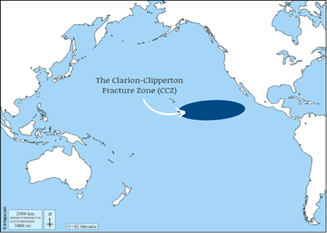
About Clarion-Clipperton Zone (CCZ):
- Location:
- It is a vast plain in the North Pacific Ocean between Hawaii and Mexico.
- Resource Richness:
- It is known to hold large volumes of polymetallic nodules containing minerals used in electric vehicles and solar panels, including manganese, nickel, copper, and cobalt.
- First discovered by British sailors in 1873, the potato-shaped nodules take millions of years to form.
- Biodiversity:
- Up to 30 cetacean populations, including globally endangered species like blue whales, can be found in the CCZ.
- 17 exploratory deep-sea mining licences have been granted in this zone.
Key Facts: International Seabed Authority (ISA)
- Establishment:
- It is an international organisation established in 1994 to regulate mining and related activities in the international seabed beyond national jurisdiction, an area that includes most of the world’s oceans.
- It came into existence upon the entry into force of the 1982 United Nations Convention on the Law of the Sea (UNCLOS), which codified international law regarding territorial waters, sea lanes, and ocean resources.
- Membership:
- It has 169 members, including 168 member states and the European Union.
- Functions:
- It is responsible for granting licences and regulating activities related to the exploration and exploitation of mineral resources in the international seabed.
- It ensures that these activities are carried out in a manner that protects the marine environment and promotes the equitable and efficient utilisation of resources.
- Headquarters:
- Kingston, Jamaica
|
UPSC Civil Services Examination Previous Year Question (PYQ) nation Prelims Q1. With reference to ‘Indian Ocean Rim Association for Regional Cooperation (IOR-ARC)’, consider the following statements: (2015)
Which of the statements given above is/ are correct?
Ans: (d)
Q2. Consider the following statements: (2021)
Which of the statements given above are correct?
Ans: (b)
Mains Q:1 Critically evaluate the various resources of the oceans which can be harnessed to meet the resource crisis in the world. (2014) |
Source: DD
Electric Mobility Promotion Scheme
Why in the news?
- Recently, the central government announced that the Electric Mobility Promotion Scheme (EMPS) 2024 will provide further impetus to green mobility and the development of the electric vehicle (EV) manufacturing ecosystem in the country.
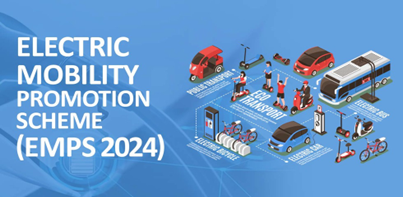
About Electric Mobility Promotion Scheme:
- Objective:
- It aims to further accelerate the adoption of electric vehicles (EVs) in the country.
- Funding:
- It is a fund-limited scheme with a total outlay of Rs. 500 crores for a period of 4 months.
- Focus Areas:
- The scheme targets the faster adoption of electric two-wheelers (e-2W) and three-wheelers (e-3W) to enhance green mobility and develop the EV manufacturing ecosystem in the country.
- Scheme Duration:
- The scheme duration is from April 01, 2024, to July 31, 2024.
- Eligible Electric Vehicle Categories:
- Two-wheelers (electric) (e-2W)
- Three-wheelers (electric), including registered e-rickshaws, e-carts, and L5 (e-3W)
- Applicability:
- The scheme mainly applies to e-2Ws and e-3Ws registered for commercial purposes.
- Privately or corporate-owned registered e-2Ws are also eligible under the scheme.
- To encourage advanced technologies, incentives will be extended only to vehicles fitted with advanced batteries.
- Eligibility Criteria:
- The EVs eligible for incentives under EMPS 2024 must be manufactured and registered within the validity period of the EMPS 2024 certificate.
Components:
- Subsidies:
- Demand incentives for e-2Ws and e-3Ws.
- Available to consumers as an upfront reduced purchase price (Rs. 5,000 per kWh) of EVs, which will be reimbursed to the Original Equipment Manufacturer (OEM) by the Government of India.
- Administration of Scheme:
- Includes Information, Education, and Communication (IEC) activities and fees for the Project Management Agency (PMA).
- Nodal Ministry:
- Ministry of Heavy Industries.
|
UPSC Civil Services Examination, Previous Year Questions (PYQs) Mains Q:1 How is efficient and affordable urban mass transport key to the rapid economic development in India? (2019) |
Source: TET
Vishnupad Temple
Why in the news?
- Recently, the finance minister announced during her Union Budget speech that corridor projects will be built for the Vishnupad Temple at Gaya and the Mahabodhi Temple at Bodh Gaya in Bihar.

About Vishnupad Temple:
- Location:
- It is located in the state of Bihar and is dedicated to Lord Vishnu.
- Historical Background:
- The temple was built in 1787 on the orders of Queen Ahilyabai Holkar of Ahmadnagar.
- Geographical Setting:
- It is situated on the banks of the Falgu River.
- Architecture:
- Architecturally, the temple stands around 100 feet tall and has 44 pillars.
- Cultural Significance:
- Devotees visit the temple during Pitra Paksha, a period in the Hindu calendar when people participate in rituals to remember their ancestors.
Key Facts about Mahabodhi Temple:
- Historical Significance:
- The temple stands to the east of the Mahabodhi Tree, where Gautama Buddha is believed to have attained nirvana.
- The temple has a unique shape and a height of 170 feet.
- Location:
- It is located in Bodh Gaya, in central Bihar, on the banks of the Niranjana River.
- Historical Background:
- The Mahabodhi Temple Complex is the first temple built by Emperor Asoka in the 3rd century B.C.
- The present temple dates from the 5th–6th centuries.
- Architectural Significance:
- It is one of the earliest Buddhist temples built entirely in brick, still standing from the late Gupta period.
- It is considered to have had significant influence in the development of brick architecture over the centuries.
- UNESCO Recognition:
- It was recognized as a UNESCO World Heritage Site in 2002.
Source: IE
Budget 2024-25: A Five-Year Roadmap for India’s Economy
Context
- The first budget of the NDA government’s third term sets forth two primary expectations for the economy: a clear roadmap on fiscal consolidation and a strategy for medium-term interventions to address the challenges facing the economy.
- The budget eye on generating employment, improving infrastructure, and rationalising GST, Budget 2024 offers some elements of a medium-term framework for economic policy.
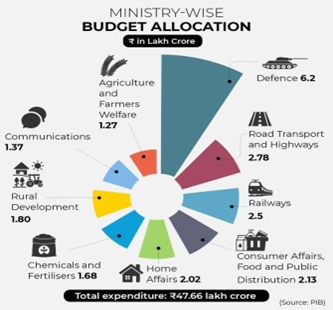
Noteworthy Aspect of NDA 3.0 First Budget: Commitment to Fiscal Consolidation
- Reduction in Fiscal Deficit:
- Fiscal deficit represents the gap between the government's total expenditure and its total revenue (excluding borrowings).
- For the fiscal year 2024-25, the budget sets the fiscal deficit target at 4.9 percent of GDP, a reduction from previous estimates.
- This target is significant as it indicates a disciplined approach to managing public finances. Furthermore, the budget aims to achieve a fiscal deficit of 4.5 percent of GDP in the following fiscal year, moving closer to the long-term goal of a sustainable fiscal balance.
- This gradual reduction reflects a strategic balance between fiscal prudence and the need to support economic growth.
- Debt-to-GDP Ratio:
- The budget projects a decrease in the central government’s debt-to-GDP ratio from 58.2 percent to 56.8 percent.
- This reduction indicates a proactive effort to manage the country’s debt levels, ensuring that debt does not grow faster than the economy.
- Lowering the debt-to-GDP ratio is essential for maintaining investor confidence and ensuring the sustainability of public finances.
- Flexibility in Fiscal Policy:
- The incorporation of flexibility in fiscal policy allows the government to respond quickly to economic fluctuations and unforeseen challenges.
- The budget does not provide a detailed roadmap beyond 2025-26, instead proposing to keep the fiscal deficit each year such that the central government debt will be on a declining path as a percentage of GDP.
- This flexibility can be advantageous in dealing with economic uncertainties, though it may limit predictability for businesses and investors.
- Utilisation of Surplus and Efficient Resource Allocation:
- In recent years, the government has utilised surplus revenues, particularly from the Reserve Bank of India, to support fiscal consolidation.
- This year’s budget continues this trend, with surplus receipts contributing to the reduction of the fiscal deficit.
- By directing additional resources toward debt reduction, the government demonstrates fiscal prudence and a long-term vision for economic stability.
Some Other Positive Takeaways from the Budget Speech
- Balancing Fiscal Prudence and Expenditure Needs:
- Fiscal consolidation often necessitates a careful balance between reducing deficits and ensuring adequate public expenditure.
- The budget achieves this balance by not only focusing on deficit reduction but also addressing critical expenditure needs.
- Over the past three years, buoyant tax revenues have provided additional fiscal space, allowing for increased allocations to various spending programs.
- This year, some of the additional resources have been directed toward fiscal consolidation, while others have been allocated to essential public services and infrastructure projects.
- This balanced approach ensures that fiscal prudence does not come at the expense of necessary public investments.
- Medium-Term Economic Interventions:
- Addressing the challenges highlighted in the Economic Survey 2023-24, the budget outlines initiatives for the current year and the next five years.
- Key concerns include employability and employment for the youth and improved infrastructure.
- Initiatives to enhance employability through skilling and higher employment through financial support for provident fund contributions are proposed.
- While these initiatives are welcome, a comprehensive framework would help identify synergies among potential initiatives.
- The proposal to present an economic policy framework is a positive step, as it can help establish consistent medium-term expectations on likely reforms.
Proposals Outlined in Budget Aimed at Rationalising Tax Structures:
- Indirect Tax Reforms: GST and Customs Duties:
- GST Rationalisation:
- The Goods and Services Tax (GST) regime has been relatively stable in terms of its structure and design.
- However, the budget signals the need for further rationalisation of GST rates. This includes streamlining the tax slabs to reduce complexity and improve compliance.
- By making the GST structure more coherent, the government hopes to boost economic activity and enhance revenue collection.
- Expansion of GST Base:
- The budget proposes to expand the GST base, and this involves bringing more goods and services under the GST ambit, thereby increasing the tax net.
- Expanding the base can help in raising additional revenue without increasing the tax rates.
- It also promotes fairness by ensuring that more sectors contribute to the tax system.
- This approach is crucial for achieving a more inclusive and balanced tax regime.
- Recalibration of Customs Duties:
- The government uses customs duties to achieve multiple objectives, including protecting domestic industries and enhancing competitiveness.
- The budget proposes regular recalibration of customs duties to address varying economic concerns.
- For instance, duties may be reduced to lower the cost of essential imports or increased to protect nascent domestic industries from international competition.
- GST Rationalisation:
- Direct Tax Reforms: Simplification and Equity:
- Review of the Income Tax Act:
- The budget proposes a comprehensive review of the Income Tax Act to make it more concise, lucid, and user-friendly.
- This initiative aims to simplify the tax code, making it easier for taxpayers to understand their obligations and comply with the law.
- Vivad se Vishwas Scheme 2024:
- To address the long-standing issue of tax disputes, the budget introduces the Vivad se Vishwas, 2024 scheme.
- This scheme aims to resolve pending litigation by offering taxpayers a one-time opportunity to settle disputes by paying a reduced amount of the contested tax.
- Limiting Appeals and Enhancing Dispute Resolution:
- In addition to the Vivad se Vishwas scheme, the budget proposes measures to limit the number of appeals by tax departments in cases involving small liabilities.
- This step is intended to reduce unnecessary litigation and focus on significant cases.
- Addressing Inequality: Taxing Capital Gains and High-Income Earners:
- Globally, there is an increasing concern about rising economic inequality and the need for progressive taxation.
- The budget addresses this issue by proposing higher taxes on capital gains, both short-term and long-term.
- While this move may impact investors, it is intended to ensure that those who benefit significantly from capital markets contribute their fair share to the economy.
- To balance this, the budget raises the exemption limit for retail investors to Rs. 1.25 lakh, providing relief to small investors.
- Enhanced Securities Transaction Tax (STT):
- Additionally, the budget proposes an enhanced STT on futures and options transactions.
- This measure aims to curb speculative activities in the capital markets and bring stability.
- By cooling some of the fervour in the markets, the government hopes to reduce volatility and create a more stable investment environment.
- Review of the Income Tax Act:
Conclusion
The commitment to fiscal consolidation in the NDA 3.0 government’s first budget is evident. Balancing fiscal prudence with essential public expenditure needs, the budget lays a robust foundation for sustainable economic growth and financial stability, developing confidence among investors and citizens alike.
|
UPSC Civil Services Examination, Previous Year Question (PYQ) Prelims: Q:1 Along with the Budget, the finance minister also places other documents before the Parliament which include ‘The Macro Economic Framework Statement’. The aforesaid document is presented because this is mandated by (2020)
Ans: (d)
Mains: Q:1 Distinguish between Capital Budget and Revenue Budget. Explain the components of both these Budgets. (2021) |
Source: IE
Share the article
Edukemy’s Current Affairs Quiz is published with multiple choice questions for UPSC exams
MCQ
Get Latest Updates on Offers, Event dates, and free Mentorship sessions.

Get in touch with our Expert Academic Counsellors 👋
FAQs
UPSC Daily Current Affairs focuses on learning current events on a daily basis. An aspirant needs to study regular and updated information about current events, news, and relevant topics that are important for UPSC aspirants. It covers national and international affairs, government policies, socio-economic issues, science and technology advancements, and more.
UPSC Daily Current Affairs provides aspirants with a concise and comprehensive overview of the latest happenings and developments across various fields. It helps aspirants stay updated with current affairs and provides them with valuable insights and analysis, which are essential for answering questions in the UPSC examinations. It enhances their knowledge, analytical skills, and ability to connect current affairs with the UPSC syllabus.
UPSC Daily Current Affairs covers a wide range of topics, including politics, economics, science and technology, environment, social issues, governance, international relations, and more. It offers news summaries, in-depth analyses, editorials, opinion pieces, and relevant study materials. It also provides practice questions and quizzes to help aspirants test their understanding of current affairs.
Edukemy's UPSC Daily Current Affairs can be accessed through:
- UPSC Daily Current Affairs can be accessed through Current Affairs tab at the top of the Main Page of Edukemy.
- Edukemy Mobile app: The Daily Current Affairs can also be access through Edukemy Mobile App.
- Social media: Follow Edukemy’s official social media accounts or pages that provide UPSC Daily Current Affairs updates, including Facebook, Twitter, or Telegram channels.


